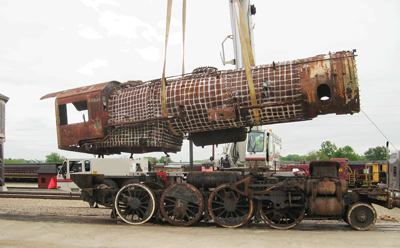Executive Director Noel Poirier tells Trains that the museum has begun a cosmetic restoration on former U.S. Army 2-8-0 No. 612. The restoration is set to be completed in time for a “Steam to Victory” event in July that will commemorate the 75th Anniversary of the D-Day invasion of Normandy, and the role played by railroads in winning World War II. The roundhouse is partnering with several reenacting and military vehicle preservationists for two days’ worth of living history, vehicle rides and exhibits, and special train displays. No. 612 will be a centerpiece of those displays.
The 612 is one of 2,120 standard design, S-160-class 2-8-0s built during World War II for railroad service in North Africa, Asia, Great Britain, South America, and much of Europe. There are eight of these 2-8-0s that survive in the United States, including sister locomotive No. 610 that has operated in previous years at the Tennessee Valley Railroad Museum in Chattanooga, Tenn. No. 612 itself was completed in November 1943 at the Philadelphia shops of the Baldwin Locomotive Works, and originally carried road number 2630. The engine never served overseas, but was assigned as a training locomotive at the U.S. Army Transportation School at Fort Eustis, Va.
The locomotive was renumbered to No. 612 in 1954, and remained on active duty for the Fort Eustis Military Railroad until the end of steam operations there 1972. No. 612 was then donated to the State of West Virginia and was placed in outdoor storage at the state’s Cass Scenic Railroad. Cass wanted to operate this 2-8-0 on the former Chesapeake & Ohio Durbin Branch, but a washout on the line pushed back the plans, and No. 612 was never fired-up.
In 2010, it was sold to Robert Franzen, President of Steam Services of America, and was disassembled and trucked to the Southeastern Railroad Museum in Duluth, Ga., for storage. The museum acquired No. 612 in May 2015, and it was moved to the Roundhouse and placed in indoor storage.
Work on the cosmetic restoration began in late 2018 as the museum began plans for special events and educational programs to be held at the museum in 2019.
Poirier thinks No. 612’s restoration and the World War II event will help visitors understand the important role that the railroads and steam locomotives played in the War.
“The restoration of the 612 and the presentation of the Steam to Victory event this summer is intended to illuminate the important role played by railroads, and steam locomotives particularly, to the achievement of ultimate victory in World War II,” he says.















“The locomotive was renumbered to No. 612 in 1954, and remained on active duty for the Fort Eustis Military Railroad until the end of steam operations there 1972.”
In June 1972 the last active duty railway battalion, the 714th, was inactivated, but that wasn’t the end of steam operations at Fort Eustis. In early 1975 my unit, the little 1st Railway Detachment, we had a steam locomotive up and running for an open house. The locomotive made three trips around the loop before being taken out of service, Soon thereafter I departed for an assignment in Germany and I’m told by unit members who remained behind that the steam locomotive was soon shoved into the Transportation Museum near the front gate and it never ran again. It’s still there today.
The US Army did not give its locomotives “classes” like “S-160”. This myth was started by a British author, Tourrett who wrote a number of otherwise useful books on Allied War Locomotives of the second World War. Alco used a shorthand description of locomotives in its tabulated lists of locomotives built. The US Army WWII 2-8-0s were listed as “280-S-160” which stood for a 2-8-0, superheated, which weighed 160 000 lbs for the locomotive alone.
At some stage Tourett took this as some sort of US Army designation, and since then, similar imaginary “classes” based on this Alco shorthand have been used for the Middle East British WD 2-8-2s “S-200” and even the Army 0-6-0 tanks “S-100”. This required some imagination, since none of these were built by Alco.
Of course, every locomotive in the Alco list has such a shorthand description. The well known UP Big Boy appears as 4884-S-800. By the logic above, everybody should call them “S-800” since there is as much justification for that as for the US Army locomotives.
It is unfortunate that one man’s error (or wishful thinking) has been so widely adopted with no ducomented justification. It would be good if “Trains” took a lead and stopped using this imaginary classification.